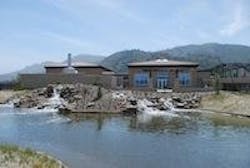Water Treatment Upgrade
The city of Santa Paula, Calif. is home to the first large-membrane bioreactor (MBR) installation in North America to use PURON membrane filtration modules. It is also the first water recycling facility built under a California government code to encourage private investment to solve public infrastructure needs.
Santa Paula’s outdated wastewater facility was in violation of several discharge requirements issued by the Los Angeles Regional Water Quality Control Board and had received more than 3,000 violations and $8 million in fines.
To comply with the increasingly stringent requirements, Santa Paula opted for a design-build-operate-finance strategy to construct a new state-of-the-art membrane bioreactor water treatment facility. The project was awarded to a team including Pacific Environmental Resources Corporation (PERC), Alinda Capital LLC, Pacific Advanced Civil Engineering and Trussell Technologies Inc.
The Challenge
Build a new treatment facility to meet current and future wastewater treatment needs while complying with strict environmental standards. The city also wanted to reuse water for irrigation.
The Solution
Santa Paula chose MBR technology because it combines biological wastewater treatment and membrane filtration into one unit process, producing a consistently high-quality effluent in an extremely compact footprint. The PERC project team selected single header PURON membrane filtration modules to incorporate into the MBR design because they are energy efficient and provide significantly lower lifecycle costs than other technologies available.
PURON submerged membrane modules produce high-quality effluent that can meet stringent water reuse and recycling requirements while significantly reducing the treatment system footprint, installation cost and manpower commitment, all key requirements for the Santa Paula site.
The Santa Paula facility uses the 1,500 sq-meter PURON module, which is designed for today’s large-scale MBR projects. The improved submerged membrane module features greater packing density, lower energy costs for aeration and simplified installation while providing even greater compatibility with other commercially available systems. Features such as an optimized permeate extraction manifold and air supply lines reduce the number of piping connections during installation.
The Treatment Plant
The Santa Paula MBR facility has a compact design with fully redundant headworks, conservative and efficient aeration design, biological foam spray system and hollow fiber membranes with incorporated aeration. Effluent from the system will discharge into evaporation/percolation ponds and a portion of the water will eventually be used for irrigation.
The facility produces an effluent that meets or exceeds all current environmental wastewater quality standards mandated by the U.S. Environmental Protection Agency and the Regional Water Quality Control Board. The MBR is designed to produce a finished effluent with BOD and TSS concentrations of less than 5 mg/L and total nitrogen less than 7mg/L, as indicated in the table below.
The plant’s innovative design uses five acres less land than would be required by a conventional wastewater treatment facility. The plant includes a recycling education center, where local students can learn how water-recycling facilities operate.
Overview of Product Used
PURON modules are designed to provide significantly lower lifecycle costs, including a single header design that provides better solids management in the module, braided fibers to reduce the risk of fiber breakage and highly-effective air scouring that virtually eliminates sludging.
An important advantage of the patented PURON module is the use of a single header with reinforced follow fibers that are fixed only at the bottom. The free-floating tip design eliminates the build up of hair and fibrous materials that typically clog the upper ends of membrane fibers in MBR module designs that employ both top and bottom headers.
